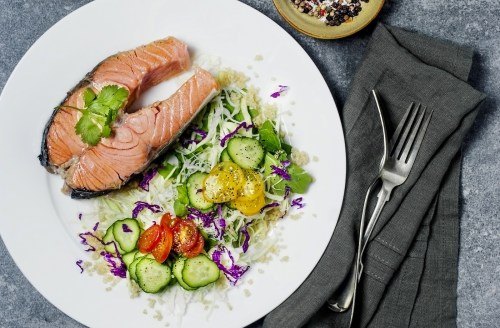There’s no denying that the Mediterranean diet has long been touted as one of the healthiest eating plans for longevity, heart benefits, and more. In fact, just this year it was named the top diet in US News and World Report’s annual ranking.
Why? Well even though diets like keto and Paleo are right on trend, the Mediterranean diet never (and probably won’t ever) go out of style, as it’s sustainable and easy to implement without the onerous restrictions of these “up and coming” diets. It’s also backed by a wide variety of scientifically-proven benefits. It’s been shown to lower the risk of heart disease and Type 2 diabetes, says Kelly Jones MS, RD, CSSD, LDN, and it’s rich in fiber, antioxidants, and other phytochemicals to make it a great anti-inflammatory way of living, she adds. “On top of that, we are seeing diets very rich in fiber and plants are able to better support the microbiome, or the balance of healthy flora in our gastrointestinal tract,” she adds.
However, it’s not always clear what it actually looks like to eat a Mediterranean diet on a day-to-day basis. I know there’s lots of olive oil involved, some wine, and definitely some salmon…but apart from that, because the eating plan is so broad, it’s kind of hard to know if you’re doing it right. That’s why I talked to nutrition experts to get a breakdown of the Mediterranean diet macros, plus what a healthy, well-portioned plate would look like.
Curious about other benefits of the Mediterranean diet? This video has you covered:
Start with vegetables—lots of them
“If I were to build a plate I would load about 50 percent with darkly colored vegetables like leafy greens and beets in a salad,” says Dana Angelo White, MS, RD, ATC. “To mix things up I would have roasted veggies like broccoli, tomatoes cauliflower and carrots.”
It’s better to go with more greens and less-starchy veggies when possible, and leave the starchy ones, like squash, sweet potatoes, and white potatoes, for the carbohydrates section. However, you can use these in the veggie section if you are creating a mix of these other lower-carb and high fiber greens. And always—go for the rainbow. Peppers, zucchini, tomatoes, and more!
You can also enjoy fruit—such as with yogurt for dessert with salad for sweetness. Some Mediterranean diet-approved fruits are grapes, apples, dates, berries, melons, peaches, citrus, tomato, and avocado, says Jones.
Carbs should be 25 percent of your meal
Mediterranean living is nothing like keto—carbs are welcomed. “Whole grain carbs are recommended, so 25 percent of the plate would be designated for healthy fiber-filled carbs and the occasional sweet treat,” says White.
But the pro-carbs stance doesn’t mean it’s fettuccine alfredo night every night. Jones says the best whole grains for this eating plan include whole wheat pasta, spelt-based breads, brown rice, quinoa, and oats. “Starchy vegetables such as sweet potatoes, corn, and pumpkin may make up this additional section of the plate too,” she adds.
The remaining 25 percent of your plate should be protein
“Lean protein from fish, poultry, even lean beef can be included in moderation,” says White of the best protein options for the Mediterranean diet. However, make sure it takes up just one-fourth of the plate, she says (aka that last remaining quarter)—which should be about four to five ounces of protein.
“Don’t forget about plant based proteins like beans and legumes – they also pack a protein punch,” White adds. You can also have eggs, says Jones, so feel free to whip up a veggie frittata or nosh on hard boiled eggs for a snack.
Finish with a small amount of fat
While you won’t make fats 80 percent of your daily calories like you would on keto, you should be eating them in moderation and throughout the meal. “A general rule can be for a quarter of one’s energy intake to come from fats. They’ll be used to mix into or top dishes, or to be used in cooking, dressings and sauces,” explains Jones.
“Healthy fats from olives, olive oil, hummus, nuts and avocado are some of the best Mediterranean choices,” adds White. “A lot of the healthy fats work along with the other foods, such as using olive oil to roast vegetables.” And if you can get fats from your protein, like fish, even better. “Fatty fish like salmon and tuna are also encouraged so those cover some protein and fat at certain meals,” White says.

What does a sample plate look like?
It’ll vary depending on the person and their specific calorie needs, but White suggests making a plate that’s packed with grains, veggies, and lean protein like salmon.
You might have one cup cooked quinoa, two cups roasted vegetables (with olive oil) and four to five ounces of cooked protein, like fish, White says. Or try a large bowl with lettuce and grilled veggies (like asparagus and roasted red pepper), add seasoned chickpeas and/or lentils for a plant-based protein, some cheese and olives for fat, and tabouleh or quinoa for your grains.
Are these proportions universal for all meals?
Yes and no. “Refreshingly this diet isn’t fixated on ratios and macro or calories counting so there is lots of flexibility,” says White. “Meals and snacks should be balanced to be satisfying but there are not rules.”
Still, this ratio is a good template for all Mediterranean-based meals, whether it’s breakfast, lunch, or dinner. However, Jones says to feel free to adjust your portion sizes based on your daily activity, what time of day it is, and more. “People don’t eat the same exact food, total energy or portions every day, since the body may require different amounts of food each day. Often, people in Mediterranean communities do a better job listening to their bodies needs than in the U.S.,” she says. “It’s normal to feel more hungry some days than others, which is why it’s not a perfect science when telling people what to eat or what their plate should look like when following a Mediterranean pattern.”
Having said that, the Mediterranean style is generally to have a larger lunch, often drawn out over multiple courses, and a smaller breakfast and dinner. Dessert is often just some fruit with yogurt, wine, or espresso, says Jones. In all things, be sure to eat slowly, enjoying your food with good company. It’s the Mediterranean way.
Looking for more Mediterranean meal ideas? Try these Instant Pot recipes. And if you’re looking to change things up (and still get major health benefits), why not check out the Okinawa diet?
Sign Up for Our Daily Newsletter
Get all the latest in wellness, trends, food, fitness, beauty, and more delivered right to your inbox.
Got it, you've been added to our email list.











